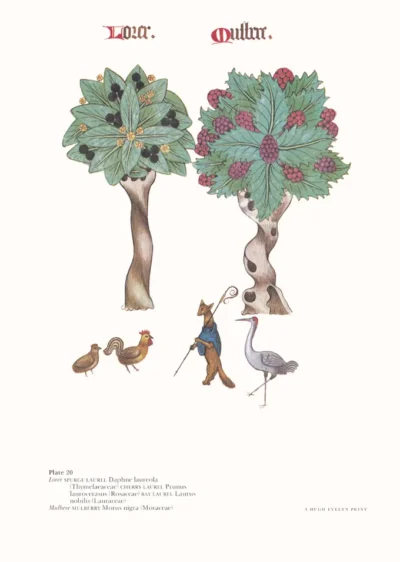Great Plantain & Tansy
£20.00
Great Plantain and Tansy (scroll down for a more detailed Description)
Published 1972 by © Hugh Evelyn Limited; drawn around 1525, these images were finished in gouache and watercolour (see description here)
Size: c. 23 x 33.5 cm [9 ″ x 13 ¼ ″] may vary slightly from printers’ cut 50 years ago
Printed on high white matt cardstock 144 g/sm2.
Print is STANDARD size – shipping is the same for 1 to 10 prints (based on largest print size in your order) – see Shipping & Returns.
In stock
Description
Weybrode: Plantago major (broadleaf plantain, white man’s foot, or greater plantain) is a plant in the plantain family Plantaginaceae. The plant is native to most of Europe, northern and central Asia and is widely naturalised elsewhere. Called Great Waybrede, Waybread or Waybroad in parts of northern England, the generic name Plantago derives from the Latin planta – foot – the broad leaves pressed to the ground. When introduced into New England, Australia and New Zealand it was called Englishman’s Foot. In a recent analysis from the summit of Plynlimon (a massif dominating northern Ceredigion, Wales) successive increases in Plantain pollen in layers of peat bog reflected clearance of forests in Neolithic, Bronze, Iron Age and mediaeval times. An Anglo-Saxon poem refers to Plantain as ‘Waybroad, Mother of Worts’, and was highly regarded. Surviving pedestrians and cart wheels it was used to heal crushing, tearing and bruising. It is one of the most abundant and accessible medicinal herbs and contains allantoin, aucubin, ursolic acid, flavonoids, and asperuloside. Rider Haggard (1) says that the Norfolk Poacher’s grandmother advised Plantain for ‘limbago’. Enid Porter (2) records a decoction of the leaves of Plantain is a sure remedy for the disease of the bladder, and the leaves are still recommended for insect and nettle stings (though not snakebite, despite the American name of Snakeweed). Grigson (3) reproduces a woodcut from Mattioli (1562); Arber (4) has a small woodcut from Herbarium Apuleii Platonici (6) and a woodcut from Fuchs’ (7) De Historia Stirpium (1542), and Blunt (8) has a woodcut from a Latin herbarius of 1499. Wyld tanse: Tansy (Tanacetum vulgare) is a perennial, herbaceous flowering plant of the aster family, native to temperate Europe and Asia. It has been introduced to other parts of the world, including North America, and in some areas has become invasive. It is also known as common tansy, bitter buttons, cow bitter, or golden buttons. It is a native plant found in roadsides, hedgerows and waste places. It is common all over the British Isles and has been cultivated since the Middle Ages as a medicinal and culinary herb. Its medicinal uses were varied, since it was used both to stay miscarriages, and married couples anxious to start a family would eat salads containing Tansy. [Where there were wild rabbits there would be Tansy, and rabbits had large families]. An infusion of the leaves was used for intestinal worms and was recommended for (female) disorders such as hysteria and nausea. The aromatic leaves were mixed with cakes and puddings according to one W. H. Barrett (2) which may be beneficial for health. Parkinson (9) reported they ‘are very profitable for those stomachs that are troubled with bad humours’. But they are also unpalatable, sometimes prepared at Easter time in memory of the bitter herbs traditionally eaten by the Jews at Passover. Another use is as a repellent – protecting corn from mice, meat from bluebottle flies, and corpses from worms. Powdered Tansy leaves placed in horses’ food will make their coats shine.
Additional information
| Weight | 0.0094 kg |
|---|---|
| Dimensions | 24 × 33.7 cm |

 1895 London Gen Omnibus Co's Garden Seat Horse Bus
1895 London Gen Omnibus Co's Garden Seat Horse Bus  French and Dutch Dress, 1621-1625
French and Dutch Dress, 1621-1625  Court Dress, 1777
Court Dress, 1777  Domestic and Court Dress Dress, 1665-1670
Domestic and Court Dress Dress, 1665-1670  Orpine & Royal Fern
Orpine & Royal Fern 



